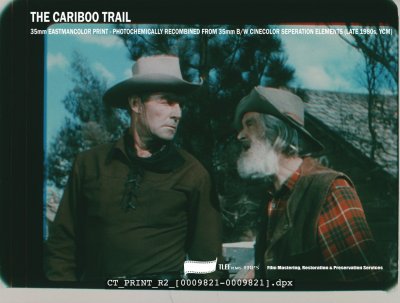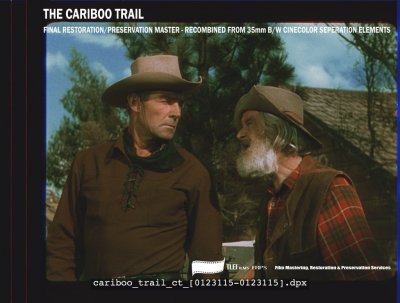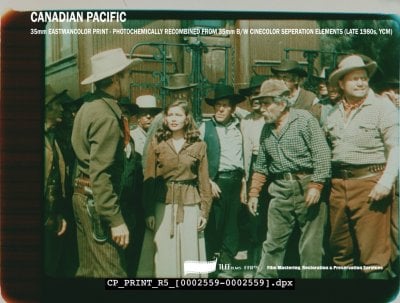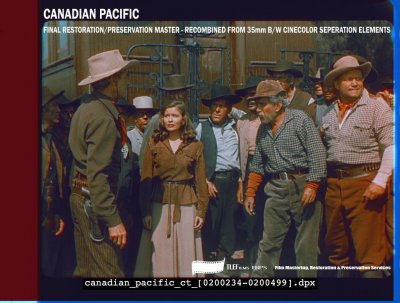haineshisway
Senior HTF Member
Badly scanned, To Catch a Thief is from a trailer, which is completely idiotic, and while it's hard to tell, some look like they're 16mm.
Be advised, many of those frames are badly scanned.




Reading the posts in this thread that followed the initial starter from Bob Harris I increasingly got the impression that his initial message got lost in the thick of opinions and interpretations and perhaps it is best to pause for a moment here.
To be absolutely fair, I believe that the intention of the makers of that Swiss website was never to claim that these displayed frames should or have to be accepted as reference material with regard to respective the color processes or the quality of the scans themselves.
It is rather a website that tries to as best it can to explore the various color processes and their respective differences with mere footage examples, nothing more.
I myself got interested in this discussion when the comparisions to "references" in Technicolor and especially CINECOLOR film footage came up. As we here are now (after long 14 months so far) at the final stage of completing the restoration/preservation of two CINECOLOR productions with Randolph Scott (THE CARIBOO TRAIL was just finished, CANADIAN PACIFIC is edging closer to the finishing line) the posts caught my eye.
Now, the question Bob Furmanek raised whether the display of frames that do not correctly represent the color process visually is counterproductive is a very vaild one. But, unfortunately, I also have to say that he by re-posting the rather very crude digital camera images that were evidently taken from a projected image of that footage by the seller of that ebay auction offering a 16mm CineColor element has muddied the waters himself quite considerably, though not intentionally. The images may be different, yes. Are they a more reliable source/a reference ? Most certainly not. It underlines VERY MUCH what Bob Harris wanted to remind everyone of, which is that a print, especially a reduction 16mm, is A PRINT, not THE PRINT, and certainly not a valid reference. It can give clues, confirm certain things - but these (especially at the 16mm level) are extremely few and one has to know precisely what to look for.
With regard to the two component (Orange/Red - Cyan/Blue) CINECOLOR process it has to be said that if it was one thing - it was notoriously fickle. The range was such that certain color values could not be reached. However, if EVERYTHING as was done right during production, development and minting processes in photochemical post, the image quality this limited process was actually capable of was nothing short of impressive, in fact, very impressive. It went far beyond what was displayed here in this forum or elsewhere.
But, at the same time, if the quality level in craftsmenship deviated only a little bit in one or all of the (production) stages the image quality could be anything but.
The restoration of the mentioned films confirmed very much how difficult this process really was in handling; consistency was, evidently, a huge issue. And this perhaps explains best why the restoration/preservation (which was made at native 2K level from B/W CineColor seperation masters - the nitrate OCNs are no longer existent (scans were made on identical IMAGICA Imager XE Scanners for both nitrate and safety B/W sep elements) was so extremely complex. The re-combining had to be made in tiny little steps in order to insure the correct color rendition as well as to minimize the misalignment as best as technically possible, the same going for instabilities, etc..
When we have finished I hope to have the time to come back here and provide a bit more detail on this subject. As for some comparison and (in this case, indeed, reference) some CineColor material and what the color process was - on best occasions - capable of I will post here frames from a) a 35mm Eastman Print made by YCM in the late 1980s re-combining CineColor seps and b) identical frames of the Final Restoration/Preservation Master of the respective film. It clearly shows the extreme difficulties the Eastman process had, both with regard to hardware and photochemically, to do the CineColor process true justice. Remember that the images are compressed as the upload is beyond our control.
View attachment 29392 View attachment 29393 View attachment 29390 View attachment 29391

 ... ???
... ??? The only thing I can think of on par with such idiocy was Disney's decision to junk the optical audio negs for Fantasia after transferring to magnetic. Over phone lines. They were so called "high quality" phone lines, but even the way phones sound today, why would you do such a thing?Excellent addition to thread. Thank you.
One very minor correction. Like Technicolor b/w positive protection elements, Cinecolor were not separations, as nothing was being separated. They were fine grain masters.
The only Technicolor seps of which I'm aware, outside of the few Kodachrome productions of the early 1940s, were the seps produced by deluxe, from the abhorrent CRI's they created from the Fox Tech productions.
They must have spent a great deal of energy trying to come up with a preservation methodology that would be the worst possibly attainable.
Expose the three Technicolor records to CRI stock, with no attempt at registration, or reproduction of shadow detail. Then take said CRI, and separate to three black and white positives.
To preserve the entire Fox library, all they needed to do was strike fine grains of the three negatives.
I never get over this idiocy.
And then, of course, the coup des grace. Junk the Technicolor originals and masters rather than donate to an archive. The choices of archives were many.
I need to keep reminding myself not to think about deluxe. Makes me cranky.
RAH
Two excellent examples on DVD of recombined nitrate Cinecolor elements are ALBUQUERQUE from Universal and PRINCE OF THIEVES from Sony.
I highly recommend this new book on the Dawn of Technicolor:
http://www.eastmanhouse.org/dawnoftechnicolor/




